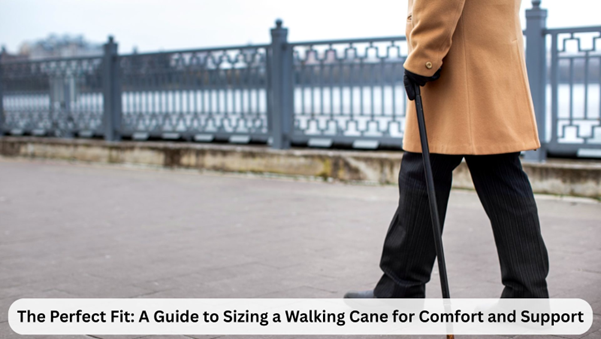A walking cane is one of the most resourceful mobility aids for seniors. Investing in a proper walking stick can improve your posture and stability. The products let you navigate different terrains with remarkable ease, enhancing your independence.
Walking canes are particularly beneficial for individuals with severe lower-body mobility impairments. If properly deployed, the sticks can reduce the worrying fall statistics among older adults.
However, all walking canes aren’t made equal. Extensive research is paramount while scouting for the best stick for your mobility needs. Here’s a definitive guide to sizing a walking cane for maximum comfort and support.
1. Begin With Initial Consultations

Photo Credit: Pixabay.com
Most disabilities require professional diagnosis. After extensive examinations, a physician will determine if your condition is reversible or progressive.
Good luck if the doctors are able to treat your disorder. But if the disease requires ongoing management, one of the best coping strategies is using a walking cane.
It is best to consult a nearby physician for optimal support. For instance, if you are based out of Canada, always consult a board-certified physician before you go shopping for walking canes for seniors in Canada.
Whether it’s a physiotherapist, osteopath, or chiropractor, the specialist’s advice can help point you to a product that addresses your unique needs.
2. Assess the Level of Support Required
Numerous balance disorders may necessitate a walking stick. Examples include arthritis, osteoporosis, heart disease, and Parkinson’s disease.
However, these illnesses can vary considerably in intensity. Assess your condition’s severity while choosing the right walking cane.
Ideally, the choice comes down to;
a) Regular Canes
Regular walking canes feature standard bases for providing minimal support. They’re perfect for less severe mobility disorders that require limited-to-moderate stability and posture correction.
b) Quad Canes
Quad walking canes stand out for their four-pronged bases, enhancing their weight-bearing capabilities. They’re ideal for seniors looking for extra sturdiness, such as those suffering from severe osteoporosis.
c) Specialized Canes
Specialized walking canes are tailored to address more nuanced mobility needs, such as leg length discrepancies.
3. Examine the Height

Photo Credit: Pixabay.com
How long should a walking cane be?
Unsurprisingly, the answer depends on your individual height. Using a shorter walking cane can exert undue strain on your wrist. Ultimately, shorter canes could loosen your shoulder blades and exacerbate your mobility condition.
To pick the correct walking cane height, grab the stick with your dominant hand and hold it upright next to you. Check that your elbows bend at a comfortable angle of 15 – 20 degrees.
Alternatively, bring the walking cane against your side and let your arms hang straight down. The stick’s upper tip should align with your wrist’s crease.
4. Inspect the Weight
Many physical disabilities put excess pressure on our muscles. So, the last thing you need is a walking cane that adds extra baggage.
Standard walking sticks can safely bear up to 25% of your body weight. However, that shouldn’t translate to a 25-pound product if you weigh, say, 100 pounds.
Test a walking cane and ensure it’s lightweight enough to effortlessly handle with one hand. It’s best to try it out with your non-dominant hand.
5. Balance Between Weight and Stability
Photo Credit: Pixabay.com
Lighter walking canes may be easier to handle. But they can prove unreliable for larger users with severe balance disorders.
Fortunately, reputable walking cane stores maintain vast collections of sticks for different seniors. If you’re struggling to balance between the ideal cane weight and the required support levels, simply consult the company’s sales representatives for assistance.
6. Research the Material
Walking canes can be fashioned from several materials. Popular options include aluminum fiber, carbon fiber, titanium, and wood.
Aluminum and carbon fiber are remarkably lightweight. They’re your best bet if you’re looking for a walking cane that’s easy to handle.
Better yet, you may choose lighter and stronger titanium sticks. In contrast, wooden walking canes tend to be heavier. While that may be a drawback in terms of the ease of handling, you get improved stability as a trade-off.
Besides, wooden walking canes sport a rustic, classic appearance. Not to mention their customizability.
7. Check the Handle Types
Walking cane handles come in multiple styles, each impacting your hand grip and overall stability. Don’t just settle for the traditional T-shaped handles. Instead, look out for extra ergonomics.
Ergonomic handles ease the strain on your wrist and shoulders by redistributing your body’s weight evenly to the ground. They’re excellent if you require a walking stick for severe disability or long-term usage.
Even better, choose walking cane handles with padded grips for extra comfort.
8. Don’t Forget the Intended Use Environment

Photo Credit: Pixabay.com
Are you looking for a walking cane for indoor or outdoor usage?
While a regular wooden stick may serve your needs indoors, you need a cane fashioned from robust aluminum for outdoor applications. Aluminum is remarkably lightweight yet durable and impact-resistant.
The metal’s durability stems primarily from its anti-rust and anticorrosive properties. However, note that outdoor walking canes must be considerably heavy for maximum support while navigating uneven terrains.
Keep that in mind while choosing aluminum sticks.
Unlock the Ultimate Freedom With a Properly Sized Walking Cane
A properly sized walking cane can improve your stability, minimizing the risks of falls due to balance disorders. However, choosing a correctly sized walking cane is critical to unlock its numerous benefits.
We hope this post can serve as your practical handbook for selecting a walking cane that suits your mobility requirements. It’s also worth emphasizing that walking canes may only help correct basic posture and balance issues. For maximum protection from falls, consider pairing these sticks with an advanced medical alert system.
https://www.africanexponent.com/the-perfect-fit-a-guide-to-sizing-a-walking-cane-for-comfort-and-support/


